Farmers are using hay supplies earlier than expected to feed cattle, and duck guide services are pumping water into fields to attract fowl a week before hunting season opens, because of a lingering drought in the state.
More than 86 percent of Arkansas is in some form of drought, according to a weekly report issued by the National Drought Mitigation Center at the University of Nebraska-Lincoln. Three months ago, only 32 percent of the state was considered "abnormally dry" -- the least-severe ranking the center gives for drought conditions.
The driest area is in the southwest corner of the state where nine counties are deemed to be in a "severe drought," meaning the area's rainfall for the past 30 days was 3 to 4 inches below normal.
Nearly three-fourths of the state, south of a line from Jonesboro to Fort Smith, was classified as being in a "moderate drought," meaning the area was 2 to 3 inches below average in rainfall for the past 30 days.
Only the northernmost tier of Arkansas counties remained drought-free, according to the center.
"Everyone is running out of grass," said Jason Needham, manager of the Southeast Feed store in De Queen, referring to pastureland for cattle. "Farmers ran later in the summer with pasture grass than before because of the earlier rains. It was pretty good until now.
"If we don't get rain come spring, it'll get really bad."
Because of heavy rains in August, the drought is off to a later start than usual in Arkansas, said Deborah Bathke, a meteorologist with the Nebraska drought center. Normally, droughts begin earlier in the summer when temperatures are higher and the climate is dry.
"It looks like this could be a very persistent drought," she said. "It's going to remain [in Arkansas] for a while."
The formation of a La Nina, a cooling of the waters in the equatorial Pacific Ocean, will force weather patterns to trend farther to the north and keep most moisture-producing systems away from Arkansas, she said.
The La Nina could reduce drought conditions in California, which has seen extreme drought for the past six years, Bathke said.
Farther east, a ridge of high pressure over Alabama and Georgia has kept rain at bay, creating a serious drought there -- much like one that struck Arkansas in 2012. All of Mississippi is in some form of drought, and the northeastern quarter is considered to be in "exceptional drought" -- the worst classification the center gives to drought conditions when areas have recorded rainfall more than 5 inches below normal over the past 30 days.
The northwest corner of Georgia is also in "exceptional drought."
Long-range forecasts call for a warm, dry winter in Arkansas and the South, Bathke said.
"You've got that high-pressure system sitting in the region and you add the warmer fall temperatures of 6 to 10 degrees above normal," she said. "The forecast predicts there's not much moisture ahead. All that creates some bad conditions."
Wheat farmers in the state are hoping for rain in February after they plant their second crops, said Steve Eddington, a spokesman for Arkansas Farm Bureau in Little Rock.
"It's the best time now for a drought if we have to have one, since it's harvesting time," he said. "But we need rain for the spring. You can't plant in the dust."
Dry conditions have prompted 15 county judges in the state to issue burn bans that prohibit the burning of any debris, brush or trash. Under burn bans Friday were Arkansas, Ashley, Bradley, Chicot, Cleburne, Cleveland, Cross, Faulkner, Hempstead, Jefferson, Logan, Monroe, Ouachita, Poinsett and White counties.
The Arkansas Forestry Commission rated the entire state as "moderate" for fire danger. A sliver of Northwest Arkansas that included Crawford, Franklin, Logan, Sebastian and Washington counties was rated as being "high" for fire danger, and burning there was discouraged by the commission.
In Altheimer, workers for the Duck Down Guide Service pumped water on 4,000 acres of fields to provide habitat for migrating ducks. Duck hunting season opens Nov. 19.
"It's all about location," said Tiffany Henderson, who owns the service with her husband. "We've got to put water on them to get the ducks here."
She said it's costly to do it, but her husband owns farm irrigation equipment and can readily fill the fields with needed water.
"That does help in time of drought," she said.
Temperatures are expected to drop to the mid-30s in the state tonight and then only reach the upper 60s and lower 70s during next week, the National Weather Service in North Little Rock forecast. Skies are predicted to remain clear through the week.
State Desk on 11/12/2016
